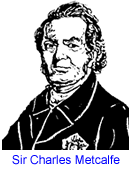
Dimdima
Online Children's Magazine from India

Dimdima
Online Children's Magazine from India
| The Battle For A Free Press |
|
James Augustus Hicky described his paper, Bengal Gazette or Calcutta General
Advertiser (1780) as "a Weekly Political and Commercial Paper Open to all
Parties but influenced by None". When the government tried to curb the paper
by instructing post offices not to accept the Gazette for delivery, Hicky hit
back: "Mr. Hicky considers the liberty of the Press to be essential to the
existence of an Englishman and a free g-t (government). The Subject should
have full liberty to declare his principles and opinions, and every act which
tends to coerce that liberty is tyrannical and injurious to the community". |
In 1835 Sir Charles Metcalfe restored the freedom of the
Press with the passing of the Press Law. "Freedom of "Public discussion," said Metcalfe, "which is nothing more than the freedom
of speaking aloud, is a right belonging to the people which no government has a
right to withhold."
of "Public discussion," said Metcalfe, "which is nothing more than the freedom
of speaking aloud, is a right belonging to the people which no government has a
right to withhold."
Earlier Sir Thomas Munro had expressed misgivings about a free press in India.
"A free press and the dominion of strangers", Munro had said, "…cannot long
exist together, for what is the first duty of a free press? It is to deliver the
country from a foreign yoke." When this line of argument was cited to oppose
liberalisation, Metcalfe retorted: "If India could only be preserved as a part
of the British empire by keeping its inhabitants in a state of ignorance, our
domination would be a curse to the country, and ought to cease".
What Metcalfe granted, Lord Canning took away in the wake of the Great Revolt by
passing Act XV of 1857 which required licenses for keeping printing presses and
gave the government the power to prohibit the publication or circulation of
books or papers it considered objectionable. One of the biggest casualties of
the Act was the Urdu Press. Many Urdu papers ceased publication. In other
languages,
including English, editors received warnings, and some were edged out.
Fortunately restrictions on the Press were withdrawn when the situation returned
to normalcy. The vernacular Press grew bolder and bolder in its criticism of the
government. In 1878 Lord Lytton, in order to put a check on the non-English
papers which were becoming increasingly hostile to the government came out with
the Vernacular Press Act. Under the Act the government could prevent publication
of anything likely to give rise to feelings of disaffection against the
government.
The vernacular Press protested against the Act. Somprakasha ceased publication
and Amrita Bazar Patrika, until then a bilingual, overnight changed into an
English paper to escape from the purview of the Vernacular Press Act.
In 1882 Lord Ripon won public acclaim by repealing the Acts of 1857 and 1878.
The Indian Press was now very clear about what its role was : to oppose the
government. The Indian press became an instrument in educating public opinion
and inculcating patriotic and national views among the public. However, the
English Press owned by Europeans took an alarmist view of the rising tide of
patriotic fervour in the country and reacted strongly prompting Lord George
Hamilton, the Secretary of State to write to Lord Curzon in 1900 :
"We, from time to time, abuse the Native Press, and believe it to be a danger to
our rule in India. I am not at all sure that the Anglo-Indian Press is not quite
as mischievous, and by its intolerance, does not greatly aggravate all racial
difficulties and differences."
Dimdima is the Sanskrit word for ‘drumbeat’. In olden days, victory in battle was heralded by the beat of drums or any important news to be conveyed to the people used to be accompanied with drumbeats.
Bharatiya Vidya Bhavan
K. M Munshi Marg,
Chowpatty, Mumbai - 400 007
email : editor@dimdima.com
Bharatiya Vidya Bhavan
505, Sane Guruji Marg,
Tardeo, Mumbai - 400 034
email : promo@dimdima.com
Dimdima.com, the Children's Website of Bharatiya Vidya Bhavan launched in 2000 and came out with a Printed version of Dimdima Magazine in 2004. At present the Printed Version have more than 35,000 subscribers from India and Abroad.